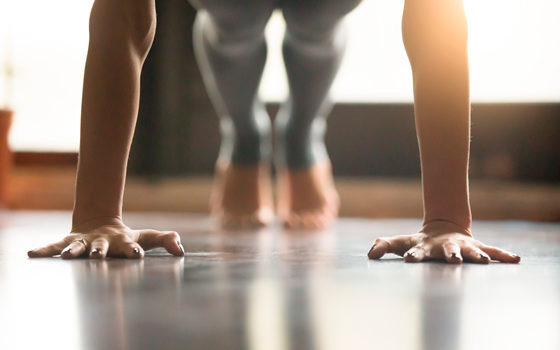Being in good shape is without a doubt an asset when overcoming adversity and meeting the challenges life sets upon our path.
We are all responsible for our own well-being and health, which is why it’s important to take charge. Improving the quality of our lives is possible; we simply need to want to change. I suggest a training program with various complementary add-ons including Pilates, yoga, relaxation, and meditation for the ultimate in well-being.
Focusing on certain muscles only creates muscle imbalances and increases risk of injury.
It’s important to recognize which muscles are working when performing a movement, and to know how to execute the movement safely and effectively.
Here are explanations for each of the exercises on the workout sheet with equipment (stability ball and free weights).
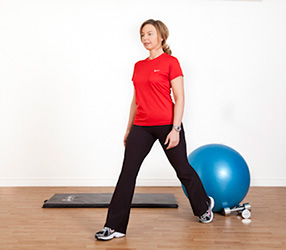
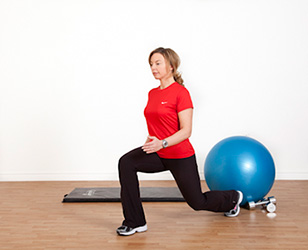
Lunges
Take a big step forward and spread feet about shoulder width apart.
Stabilize your core by contracting abdominal muscles.
Keeping your upper body straight, lower the back knee until it’s just a few centimetres from the ground. Make sure the front knee forms a 90 degree angle and does not pass your toes.
Main muscles used: buttocks, quadriceps, and hip adductors.
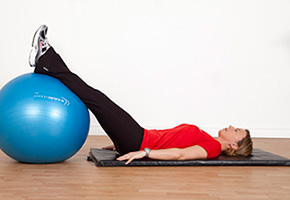
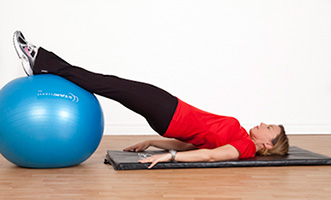
Hip Extensions With Stability Ball
Lie down on your back.
Place arms by your sides and lift legs to ball height, placing heels at the centre of the ball on top.
Lift hips to form a straight line with your core, buttocks, and thighs.
While controlling your movements, slowly lift and lower your hips.
Muscles used: hamstrings, buttocks, and lumbar extensors.
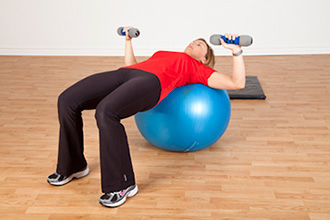
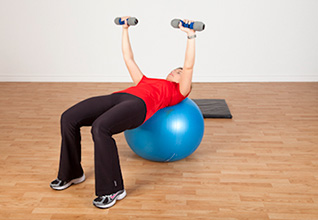
Bench Press
Sit on the ball and place feet wider than shoulder width apart.
Slide feet forward one by one until only the top of your shoulders and head rest on the ball.
Bend arms to 90 degrees, making sure your elbows are aligned with your shoulders.
Push weights simultaneously up.
Careful: Keep a slight bend in your elbows at the end of the movement.
Main muscles used: pectorals, deltoids, and triceps.
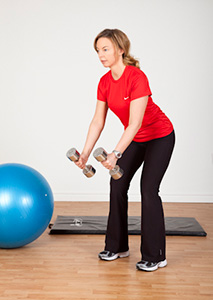
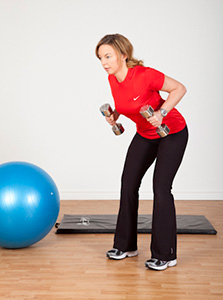
Bent-over Row
Bend knees and incline upper body to 45 degrees. Contract abs and lift weights toward your chest while keeping your elbows alongside your body.
Return to starting position, without completely releasing.
Main muscles used: back, biceps, rhomboids, and deltoids.
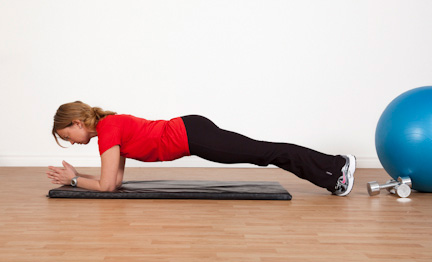
Abdominal Plank
Lie down flat on your stomach leaning on your forearms. Your elbows should be directly under your shoulders. While supported on your pointed toes with legs straight, lift your lower body from the floor so your body forms a straight line. Do not arch your back. Stay in this position while contracting your abdominal muscles.
Why train with a stability ball?
Several health professionals use a stability ball instead of an exercise bench to help strengthen the stabilizer muscles that support joints. Working with a stability ball conditions both the body and mind since you need to become aware of your posture and your movements, and that also applies whether you’re dancing or lifting a baby. A good posture helps you move better, improves agility, and prevents injuries.
Use care and stay focused when using the ball!
The ball and Pilates
Finding your balance on a ball may seem obvious, but without it, you won’t be able to execute any exercise correctly. To keep your balance you need strong and solid ab muscles.
Pilates is an exercise system developed by Joseph Pilates that tones and strengthens the body’s core (midsection musculature). This training method can help you gain awareness about your posture and correct any muscle imbalances.
Initiation to yoga: an invitation to get to know yourself
The reasons to practice yoga are many. For example, you may want to improve your flexibility, counter the negative effects of stress on your body, find serenity, or awaken your spirituality.
While yoga is the practice of a lifetime, it is possible to start gently, one small step at a time. When you begin yoga this way, your self-awareness becomes a fascinating and satisfying voyage of discovery!
Relaxation and meditation: complement your workout
Relaxation is an essential part of any process that pursues optimal health. Meditation can calm our minds, open our hearts, and produce physical benefits that have been widely documented.
Physical exercise is an opportunity to spend time with yourself, to become aware of your breathing. Use movement and exercise as a means to get in touch with the deep parts of your own self and to learn to enjoy the present moment more fully and easily.
Sophie Mc Greevy
Trainer



